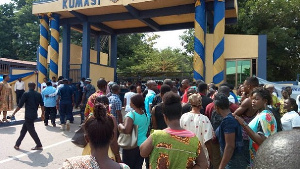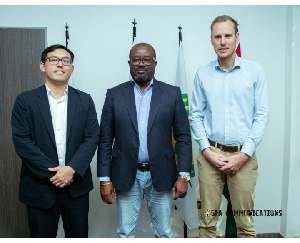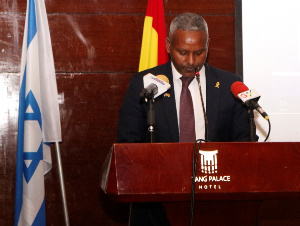Opinions of Friday, 8 December 2017
Columnist: Casely Coleman
Managing a humanitarian crises – Lessons from Kumasi Academy
The Minister of Health has now confirmed that the unexplained causes of death in Kumasi Academy (Kumaca) first reported in April 2017 and very recently for the past 2 weeks is the Influenza type A, H1N1 Pandemic strain. According to the World Health Organization, the Influenza A (H1N1) virus emerged in 2009. It is transmitted through the respiratory system mainly through droplets disseminated by unprotected coughs and sneezes. Short-distance airborne transmission of influenza viruses may occur, particularly in crowded enclosed spaces. Symptoms, which can last up to a week, are similar to those of seasonal flu and may include fever, sneezing, sore throat, coughs, headaches, and muscle or joint pains.
Complications of the disease include pneumonia and difficulty in breathing. In 2009 the outbreak caused the Mexican government to close down most public and private offices and facilities to help contain the spread. It, however, spread to the US and other countries. In June 2009, the Director General of WHO declared a phase six pandemic meaning that the disease had spread to other parts of the continent and a sustained human-to-human transmission in communities. In Ghana on August 4, 2009, the then Minister of Health confirmed Ghana’s first case. In effect this disease is not new in Ghana. This article will examine some of the lessons learnt from the past 2 weeks following the Kumaca incidents and share ideas to improve future emergency response interventions.
What Do We Know So Far
H1N1 disease is not new in Ghana, however, the initial response from government and school authorities could have been better as it appeared not well coordinated. With lack of adequate information on what was happening, parents and guardians rushed to pick their wards home fearing the worst may happen to them and this was further complicated by the media who without the benefit of accurate proactive information from the Ministry of Health, Ministry of Education created more panic with their reportage. In the midst of the confusion, some religious leaders concluded the deaths were caused by evil spirits.
Political and educational authorities had to beg guardians to bring back their children to be administered with some antibiotics since the nature of the disease enabled human to human transmission and infected students may transmit whatever virus they may have contracted to their families and close relations. Some of the parents are said to have brought back their wards and there are many others who have not yet done so. In the midst of the chaos, samples were taken from the affected students and sent to the Noguchi Memorial Institute, the country's medical research institute to ascertain what may have caused the deaths. After an investigation by the research medical institute, it has been established that the students died of the H1N1 virus.
The fear and panic that occurred and which is still not completely gone convince me that either there is lack of a contingency plan to handle the crises in Kumaca at a micro level or even where it exists, am not sure the content is well known and accessible to students and parents. It is also doubtful if there had been regularly testing of the contingency plans through simulation exercises. I will suspect this could be the case in many educational institutions as well as many offices. This then suggests to me that perhaps, at the macro level, the relevant ministries and institutions in education and health may not have a national contingency plan or if they do then it is not adequately accessible. If my assumptions are true then this should be a major priority in terms of policy-making and enforcement for the relevant agencies. In addition, the lack of coordination in messaging at the beginning of the crises was a concern and created further anxiety. A crisis of this nature requires 3 key strategies to manage a coordinated response. Leadership and structure, multidisciplinary approach and social mobilization.
Leadership & Structure
Leadership and structure are key to ensure clarity of decision space, mandate, roles, responsibilities and accountabilities. Given the nature of the disease, it will be very important for those providing leadership in managing the crises to communicate a clear disaster preparedness and response strategy and structure, which is supported by a contingency plan that provides guidance on the relevant protocols that have to be activated during a crisis. Leadership with the right structure will enable accurate communication on the risks and spread of the virus, the frequency and intensity and efforts to contain it. NADMO could be the hub for a ‘country situational room” that provides overarching country-wide leadership and structure to engage with the key government agencies and donors supporting the KUMACA response.
In a crises situation there is need for strong leadership and structure, accurate information, speed and rigor to minimize fear and manage expectations In the same vein I will like to commend the leadership and structure that was demonstrated to ensure effective case management ie relatively quick diagnosis of the causes as well administration of vaccines to the affected students. I believe that aspect of the Kumaca crises could have been better managed from that perspective and this can still improve since the virus is yet to be defeated and the response is still unfolding.
Multi-Disciplinary approach
In view of the inadequate information of the epidemic at the beginning of the crises, many Ghanaians may not be aware of the nature of the H1N1 virus and how it spreads. There is the risk of stigmatization of the students and their host families. In addition, the intensity of the frequency of the deaths over a short period of time would cause trauma to the surviving students, parents and the institution as a whole. There is the need for the provision of extensive psycho-social support including trauma counselling as soon as possible as this can affect teaching and learning outcomes when normalcy returns to the school.
While I commend the government for the clinical response to ensure the vaccines are available, accessible and utilized, this must be reinforced with extensive psycho-social support and services as well to the affected students, their parents and teachers. Providing adequate water and sanitation services will be critical to minimize further human to human transmission. I believe NADMO can coordinate in a structured way the availability and deployment of the relevant subject matter experts to ensure the children who have been affected directly or indirectly are provided with the right specialist support and services.
Social Mobilization & Surveillance
The nature of the H1N1 virus requires adequate investment to strengthen surveillance systems and protocols while reinforcing it with contact tracing to mitigate the risks of further transmission. This is another reason why discussions on the digital property address system ought to be done bereft of partisan considerations since a well well-designed property address system can facilitate effective contact tracing and surveillance. While the call by the authorities for parents to return their wards is well placed, it will be advisable for the authorities to seek the help of faith-based leaders, traditional authorities, local opinion leaders to support contact tracing as the inability to trace suspected cases who are yet to return and who may have come into contact with others could lead to a fresh cycle of transmissions.
Given the densely populated major cities and towns in Ghana, this is a potential game changer if it is not managed well. Proactive engagement with the media using relevant information that suits local content, local traditions and local perceptions must be activated immediately to sensitize Ghanaians on H1N1. There is need to prioritize resources to fund social mobilization and community engagement interventions such as using films, concerts, videos, music shows as part of sensitization and invest in simulation exercises at all levels ie in schools, offices, communities and also for public education and training on pandemic risks, preparedness and response strategies.
Conclusion
The KUMACA crises must be a wakeup call to all our educational institutions on the need to have contingency plans that are accessible to students, teachers and parents that provides clarity on the right protocols and processes to be activated during a crises situation. There must be regular simulation exercises to assess the degree of preparedness and the Ministry of Education, NADMO, Ministry of Health must collaborate to ensure enforcement and school authorities held accountable and sanctions applied where there is non-compliance.
Government as duty bearer and its related agencies must be more proactive in their preparedness and response so they can provide timely and accurate information to the students, parents and the country to demonstrate that government is aware of the problem and prepared to act and is indeed acting with the best of intentions. While we pray that this does not happen, from a risk preparedness perspective, the country must have a clear response plan in case this spreads beyond Kumaca. Kumasi is a very densely populated city and a hub for commercial activities in Ghana, it will be good if the Ministry of Health and NADMO can assure us of steps they have in place to mitigate further given the nature and mode of transmission and ignorance about the virus.
The H1N1 virus is not completely defeated and we need to keep our eyes on the ball and hold Government accountable on how the situation is managed, the Ebola crises is a painful reminder and as someone who worked at the frontline during the Ebola response, this is an issue which must attract the attention of all Ghanaians in a non-partisan way!
Finally and this is my major concern – during the 2018 budget statement, the Minister of Finance communicated government’s intent to exit from the Global Alliance For Vaccines & Immunization (GAVI). GAVI is a global public and private health partnership which brings together developing countries, donor governments, specialized agencies and philanthropists to drive research and availability and accessibility of vaccines. The H1N1 crises in Kumaca is another reason why perhaps Government may have to rethink its decision or alternatively assure Ghanaians of what alternative measures and strategic investment choices will be put in place to ensure availability of the vaccines to support health systems strengthening.
Disasters and pandemics don’t have party affiliations lets have a non-partisan discourse and consensus to ensure the country is well prepared for complex emergencies.
Casely Ato Coleman is Human Resources & Organizational Development Practitioner and was Country Director of Plan International Sierra Leone during the Ebola crises.











